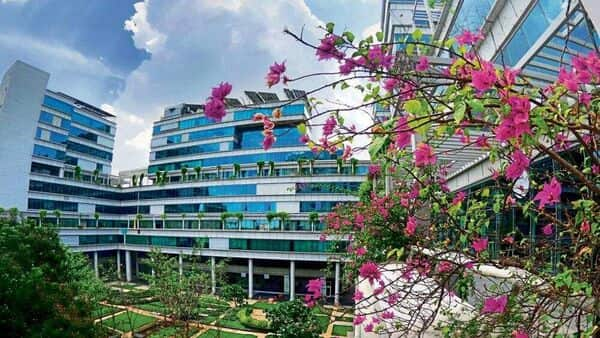[ad_1]
“Prof. Jhunjhunwala did not take more than 15 minutes to tell us what was wrong with our business plan,” says Sachdev, now the co-founder and CEO of conversational automation platform Uniphore.

View Full Image
The rest, as the cliché goes, is history. Uniphore, today, is a $2.5 billion unicorn, or a startup valued at $1 billion or more. “He (Jhunjhunwala) was one of our first mentors who taught us to be prudent and resourceful; showed us how to build a business; develop technology, and (told us) to never be complacent,” says Sachdev.
In 2010, Jhunjhunwala set up the IIT Madras Research Park, a first of its kind non-profit organisation in India, to promote industry-academia collaboration and commercialize research and development (R&D) efforts, particularly, around deep technology—deeptech firms often innovate at the convergence of cutting-edge technologies and fields that can include advanced materials and advanced manufacturing.
Uniphore became the first startup to set up office in the park.
Five years later, in 2015, two tech entrepreneurs—Tarun Mehta and Swapnil Jain—both alumni of the department of engineering design of IIT-M, uncorked the bubbly at the very same research park. They had just received a $1 million seed funding from Flipkart founders Sachin Bansal and Binny Bansal for their prototype of an electric scooter with a lithium-ion battery. We know this startup as Ather Energy today. The company is now within striking distance of being a unicorn, having recently raised about $50 million in October, a funding round that valued it at $700-800 million, according to regulatory filings sourced by business intelligence platform Tofler.
Uniphore and Ather Energy are well-known. There are scores of unknown ones here. About 280 startups have been incubated at the incubation cell of the IIT Madras Research Park, thus far. The park is also home to more than 100 R&D companies, and nine centres of excellence (COEs).
About ₹500 crore has been invested in the park till date. It received a seed funding of ₹100 crore from the IIT-M alumni as well as a subsidy from the government. Rest of the capital was borrowed from banks—the institution has paid it back. Today, it is debt free and cash positive.

View Full Image
The park started with just 10-15 companies. Today, it has three buildings and no room to spare. Such has been the demand. The cumulative revenue of all the startups in the park is currently estimated at ₹1,600 crore, while their total valuation is more than ₹33,000 crore.
This is the story of a spectacular success, and one that rode on one man’s zeal to press the accelerator on an ecosystem that fosters deeptech companies. The Indus Entrepreneurs (TIE), a Silicon Valley non-profit that supports startups, even conferred on Jhunjhunwala the title of ‘Dronacharya’.
Deeptech at play
Jhunjhunwala is president of both the IIT Madras Research Park and the IIT Madras Incubation Centre. V. Kamakoti, director of IIT-M, is also on the board of directors of the park, spread across 11.42 acres and with over 1.2 million square feet of workspace.
Jhunjhunwala commutes to the park from the far end of the IIT-M campus, one built around a forest—it is common to spot deer frolicking alongside students.
But Jhunjhunwala is quick to point out that the two institutions are separate. “We are not situated on the campus of IIT-M. Around 2007, we decided that we need a place where industry, academia and youngsters can innovate. But we also wanted a place that was a cycling distance from IIT-M so that we can foster industry-academia collaboration,” he says.
A bridge connects IIT-M with the Park. It is well known as the ‘Industry-Academia’ bridge, underlining the strong bond between the two institutions.
Here’s an example. When researchers from the IIT-M recently developed a new touchscreen display technology that allows a user to feel the textures from images as the finger moves across the touch surface (unlike existing touchscreens that can only sense the location of the finger touch), they needed to take the product to market from the R&D stage. Merkel Haptics, a startup incubated at the IIT Madras Research Park, stepped in to convert the prototype into a product that may resemble a computer mouse, and enhance user experience.
Similarly, the prototype of the ePlane was developed by the ePlane Company, again incubated at the IIT Madras Incubation Cell. Co-founded by IIT-M professor Satyanarayanan Chakravarthy, the plane is a compact electric vertical take-off and landing (eVTOL) aircraft with a five-metre wingspan. It is five metres from nose to tail and is a two-seater. Yet to be commercially launched, it is designed to be India’s first electric flying taxi.

View Full Image
Other startups incubated here include Stellapps, co-founded by Ranjeet Mukundan. It is the country’s first dairy internet of things (IoT) startup—it works at optimizing the supply chain for dairy farms and cooperatives. Planys, co-founded by Tanuj Jhunjhunwala, is building a smart underwater inspection solution. Agnikul Cosmos, founded by Srinath Ravichandran, is developing satellite launch vehicles for a payload capacity of up to 100 kgs. In July, the startup announced the launch of Rocket Factory-1, which it touts as the country’s first-ever rocket facility dedicated to 3D printed rocket engines.
“We are focused on deeptech startups, since there are very few in the country. As you succeed, other institutions will try to emulate you,” says Jhunjhunwala.
Indeed, in March 2018, the government approved setting up of eight additional research parks—one each at IIT Kharagpur, IIT Bombay, IIT Gandhinagar, IIT Delhi, IIT Guwahati, IIT Kanpur, IIT Hyderabad, and the Indian Institute of Science (IISc) in Bengaluru.
Making the cut
How do entrepreneurs reach out to the IIT Madras Research Park if they wish their startup to be incubated there?
“You can reach out to us in a formal or even informal manner,” says Tamaswati Ghosh, CEO of the IIT Madras Incubation Centre.
The centre, next, evaluates what the founders do, the business idea, and whether it’s scalable. Can it be commercialized? “Every quarter, we get about 300-400 applications. About 20-25% of the applications get converted into incubation,” Ghosh explains.
Ghosh points out that the park not only houses the startups, but also about nine COEs that are run by IIT-M faculty members. About 80 small, medium, and large multinationals have set up their R&D centres at the park. They have all helped create an innovation ecosystem that is unique.
“The key condition for anybody wanting to rent space is that they have to work with the academia. Some sort of collaborative work with the campus community—be it working with faculty, or working with students of IIT-M, and even their own employees taking up courses at IIT-M. All this is measured throughout their stay in the park,” says Ghosh.
One company in the park is public sector giant Bharat Heavy Electricals Ltd (BHEL). It has completed over 60 projects, 33 of which have been implemented commercially.
India’s largest IT services exporter Tata Consultancy Services collaborates with IIT-M on data centre power reduction, reducing energy consumption in buildings, and developing a smart water network. Saint Gobain Research India has undertaken 22 R&D projects with IIT-M faculty and students, 20 of which have been launched as profitable products and solutions in the market. Titan Industries Innovation Hub’s partnership with the IIT on material characterisation and coating, etc., has resulted in the generation of five patents.
The COEs, on the other hand, include the Centre of Battery Engineering and Electric Vehicles (C-BEEV); the Centre for Technology and Policy (CTAP); the Centre for NEMS and Nanophotonics (CNNP); the Centre for Computational Brain Research (CCBR); the Health Care Innovation Centre (HTIC); IIT Madras Bioincubator and the Robert Bosch Centre for Data Science and Artificial Intelligence.
One of the main areas of focus for C-BEEV, for instance, is to focus on battery technology and battery engineering to suit Indian conditions. The E-rickshaw, developed by the centre, is a case in point. It is a testing prototype by Lohia Auto, a Delhi-headquatered maker of electric vehicles and is fitted with a battery developed at CBEEV.
CCBR, meanwhile, is developing a solution to study the cellular architecture, connectivity and molecular architecture in human brains—an effort supported by the Indian government along with contributions from Kris Gopalakrishnan, co-founder of Infosys, and also an alumnus of IIT-M.
HTIC, too, is a multi-disciplinary R&D centre and a joint initiative between IIT-M and the Indian government’s department of biotechnology, to develop healthcare technologies for the country.
Yet another COE focuses on machine tools and production technologies. It has “identified 11 projects which, if developed in India, will boost the capital goods sector”, said the COE spokesperson. The centre, for instance, is developing a hydrostatic bearing technology, which can be used as a high-pressure machine tool for auto components. Currently, India imports these machines or imports the concepts needed to build this technology.
Way forward
Jhunjhunwala, meanwhile, is not willing to rest on past laurels. Around two years back, the board of IIT Madras Research Park “challenged us to make new plans for 2030″, says the professor.

View Full Image
“We do 45 incubations per year. The target is now 1,000 incubations. This seems impossible. So how do you do it? You can do it by not limiting yourself to IIT-M. We now plan to approach 50-100 engineering colleges, bring them here, and make them as successful as the ones we have here,” he explains.
The next target, he adds, is to press the accelerator on areas where India can be a leader. What are those? Technologies for climate change or net zero emission; assistive technologies; fintech for inclusion, since 85% people in this country have income less than ₹25,000 a year.
Jhunjhunwala also wants to identify and nurture 500 technology leaders every year. “We call them Ranchos (the nickname of Aamir Khan in the Hindi movie 3 Idiots) and make them the world’s best,” he says.
Jhunjhunwala appears to be a cinephile. His current inspiration is two dialogues from Shah Rukh Khan’s hit film Om Shanti Om. Here’s one of them:
“Kehte hain agar kisi cheez ko dil se chaho … to puri kaynaat usse tumse milane ki koshish mein lag jaati hai (If you truly desire something, the universe works to help you achieve that goal)”.
As for the “impossible” targets that he and his board have set, Jhunjhunwala concludes: “Many of these goals appear impossible but we will get somewhere, regardless of whether they happen in 2030 or later. We have nothing to lose.”
Download The Mint News App to get Daily Market Updates & Live Business News.
[ad_2]
Source link
John Miller has been writing about science, gaming, and tech culture for over a decade. He’s a top-rated reviewer with extensive experience helping people find the best deals on tech and more.


